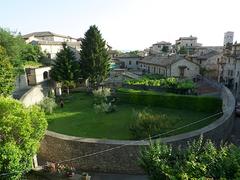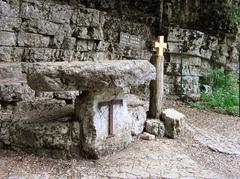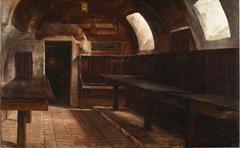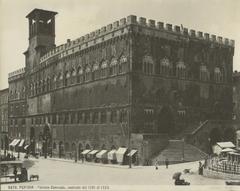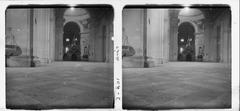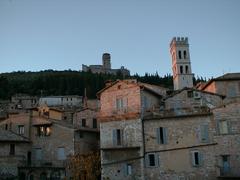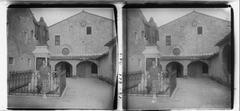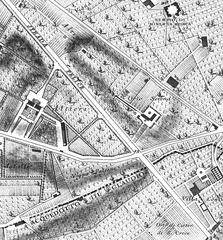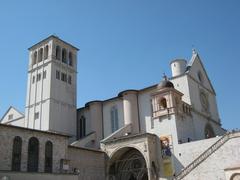San Martino Chapel Visiting Hours, Tickets, and Historical Sites in Assisi
Date: 04/07/2025
Introduction: The Spiritual and Artistic Heart of Assisi
Nestled within the Lower Basilica of the Basilica of Saint Francis of Assisi, the San Martino Chapel stands as a masterwork of medieval religious art and a beacon of spiritual heritage in Umbria. Renowned for its exquisite fresco cycle by the Sienese artist Simone Martini (1312–1318), the chapel vividly narrates the life and virtues of Saint Martin of Tours. These frescoes, commissioned by Cardinal Gentile Portino da Montefiore, encapsulate themes of charity, humility, and compassion—qualities deeply aligned with the Franciscan ethos that permeates Assisi. Today, the San Martino Chapel is not only a site of pilgrimage and devotion but also a highlight for art lovers and cultural travelers, drawing visitors into the tapestry of Assisi’s UNESCO World Heritage legacy (Eupedia; OFM Conv; Basilica di San Francesco di Assisi).
Table of Contents
- Introduction: The Spiritual and Artistic Heart of Assisi
- History and Cultural Significance
- Artistic Highlights: Simone Martini’s Frescoes
- Restoration and Preservation
- Visitor Information
- Location and Getting There
- Assisi’s Nearby Attractions
- Enhancing Your Visit
- Practical Tips
- Events and Special Occasions
- Sustainability and Conservation
- FAQ
- Visual and Interactive Resources
- Contact and Further Information
- Summary and Call to Action
- Sources
1. History and Cultural Significance
Commissioned in 1312 by Cardinal Gentile Portino da Montefiore—a prominent Franciscan and papal court figure—the San Martino Chapel reflects the intertwined religious and political currents of 14th-century Italy. Cardinal Gentile’s connection to the House of Anjou influenced the chapel’s artistic program and highlighted the virtues of Saint Martin, the cardinal’s titular saint. Saint Martin’s acts of charity and humility, particularly his legendary division of the cloak with a beggar, mirrored the Franciscan values of service and renunciation. Thus, the chapel became both a devotional site and a visual bridge between early Christian ideals and the Franciscan renewal of its era.
2. Artistic Highlights: Simone Martini’s Frescoes
Style and Innovations
Simone Martini’s frescoes in the San Martino Chapel are celebrated for their:
- Elegant Linear Grace: Elongated figures and refined gestures lend a courtly, spiritual dignity.
- Vivid Color Palette: Rich blues, reds, and golds create a luminous, immersive environment.
- Narrative Clarity: Each scene is composed for emotional immediacy and storytelling.
- Gothic Ornamentation: Decorative and architectural details showcase French Gothic influences.
Thematic Narratives
The fresco cycle unfolds in three narrative tiers, including:
- Martin Dividing His Cloak: A powerful depiction of charity and humility.
- Martin’s Baptism and Ordination: Scenes of spiritual transformation and leadership.
- Miracles and Acts of Mercy: Illustrations of healing, exorcism, and the saint’s sanctity.
The chapel’s stained glass windows, likely also designed by Martini, bathe the interior in colored light, enhancing the sense of the sacred.
3. Restoration and Preservation
Restoration History
The San Martino Chapel has undergone several restoration campaigns to address environmental wear and seismic damage. The devastating 1997 Umbria earthquake necessitated urgent structural repairs across the basilica complex (Catholic Shrine Basilica).
2022–2023 Restoration
The most recent restoration, led by chief restorer Sergio Fusetti and completed in early 2023, focused on cleaning, consolidating, and reintegrating Simone Martini’s frescoes. The project emphasized non-invasive methods and brought new brilliance to the artwork ahead of the 2026 centenary of St. Francis’s death. Restoration efforts were acknowledged by international cultural bodies and the Sacred Convent (OFM Conv).
4. Visitor Information
Visiting Hours and Tickets
- Hours: The San Martino Chapel is open daily during Lower Basilica hours, typically 6:00 am–6:00 pm. Evening prayer is reserved 7:00 pm–8:00 pm (except Wednesdays). Hours may vary on religious holidays; always check the official Basilica website before your visit.
- Admission: Entry is free; donations are encouraged to support conservation.
- Audio Guides & Tours: Available for a fee at the information desk or online. Guided tours (in multiple languages) are highly recommended for a deeper understanding.
Accessibility
- The Lower Basilica and San Martino Chapel are wheelchair accessible via ramps and elevators. Some historic areas may have uneven flooring; assistance is available upon request.
Visitor Etiquette
- Dress Code: Shoulders and knees must be covered; hats removed inside.
- Behavior: Maintain silence during Mass and prayer times.
- Photography: Strictly prohibited inside the chapel and Basilica to protect frescoes.
5. Location and Getting There
- Address: Piazza San Francesco, 2, 06081 Assisi (PG), Italy.
- Parking: Use Piazza Giovanni Paolo II; it’s a 10-minute uphill walk.
- Public Transit: Assisi railway station is 4 km away; buses and taxis connect to the Basilica.
- Entrance: Enter the Lower Basilica through the main portal; signage directs to the San Martino Chapel.
6. Assisi’s Nearby Attractions
- Upper Basilica of St. Francis — Home to Giotto’s frescoes.
- Basilica of Santa Chiara
- Roman Temple of Minerva
- Rocca Maggiore — Panoramic views of Assisi
Guided tours often include these sites for a comprehensive historical experience.
7. Enhancing Your Visit
- Art Appreciation: Use official audio guides or expert-led tours to fully appreciate Simone Martini’s artistry and the chapel’s iconography.
- Spiritual Experience: The chapel offers a peaceful setting for reflection away from crowds.
- Learning Resources: Brochures, booklets, virtual tours, and scholarly articles are available via the Basilica’s official website.
8. Practical Tips
- Bags: Large bags and backpacks are not permitted; lockers are available.
- Facilities: Restrooms and accessible facilities are near the entrance.
- Gift Shops: Religious articles and souvenirs are available nearby.
- Food: Cafés and restaurants are within walking distance in the historic center.
- Languages: Staff speak English and major European languages; signage is bilingual.
- Security: Security checks are in place for visitor safety.
9. Events and Special Occasions
- Feast Days: October 4th (Feast of St. Francis) and major religious celebrations impact visitor numbers and access.
- Concerts & Exhibitions: Occasional sacred music concerts and art shows; check the official calendar for details.
10. Sustainability and Conservation
- Do not touch frescoes or chapel surfaces.
- Donations and purchases support ongoing restoration.
- Visitor numbers may be regulated during peak times to protect the artworks.
11. Frequently Asked Questions (FAQ)
Q: Are tickets required to visit San Martino Chapel?
A: No, admission is free; donations are encouraged.
Q: What are the opening hours?
A: Daily from 6:00 am to 6:00 pm. Check the official website for updates.
Q: Is the chapel accessible?
A: Yes, with ramps and elevators. Some historic areas have limited access.
Q: Can I take photos?
A: No, photography is prohibited inside the chapel and Basilica.
Q: When is the best time to visit?
A: Early mornings and late afternoons on weekdays, avoiding major feast days, offer a quieter experience.
12. Visual and Interactive Resources
- High-quality images of the San Martino Chapel frescoes with alt text for accessibility.
- Virtual tours and interactive maps available through official platforms.
13. Contact and Further Information
- Official Website: Basilica di San Francesco di Assisi
- Visitor Information:
Email: [email protected]
Phone: +39 075 819001
14. Summary and Call to Action
The San Martino Chapel is a jewel of Assisi’s spiritual and artistic legacy. Its masterful frescoes, rich history, and recent restoration make it an essential stop for pilgrims, art enthusiasts, and cultural travelers alike. Plan your visit by checking the latest hours and visitor information, and enhance your experience with guided tours or the Audiala app. Respect the chapel’s sanctity by following dress and conduct guidelines, and consider donating to support ongoing preservation.
For real-time updates, guided audio tours, and news about events, download the Audiala app and follow our social channels. Explore Assisi’s broader historical and spiritual landscape for an unforgettable journey.
15. Sources
- OFM Conv
- Eupedia
- Basilica di San Francesco di Assisi
- Trek Zone
- Catholic Shrine Basilica
- Artnet News
- The Geographical Cure
- Italy Notes
- Wikipedia
